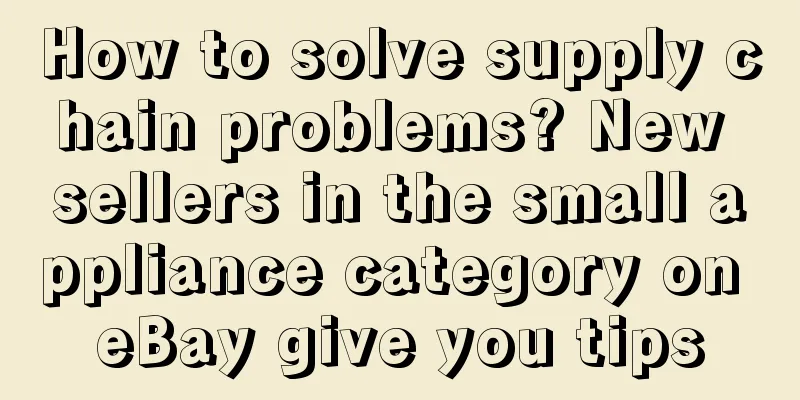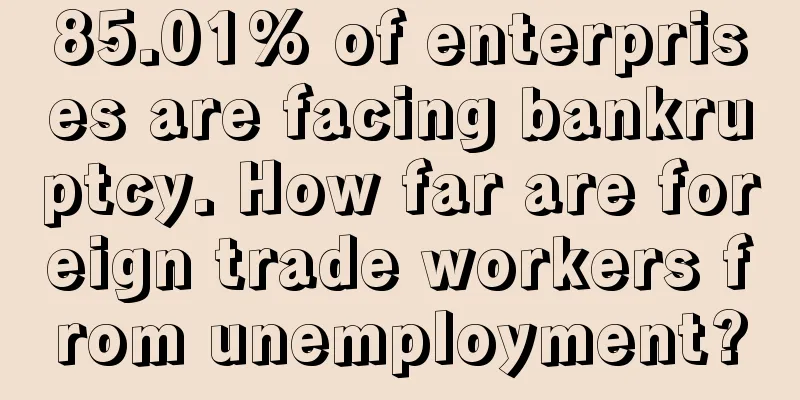How to solve supply chain problems? New sellers in the small appliance category on eBay give you tips

|
As more and more people flock to the cross-border e-commerce industry, the competition among sellers has returned from "price war" to supply chain competition. But how can we have a high-quality supply chain and make good use of resource integration capabilities? This is a big challenge for sellers. On the other hand, traditional foreign trade factories and foreign trade companies have also begun to transform into cross-border e-commerce. How to fully mobilize their own supply chain advantages and combine them with cross-border e-commerce is also a difficult problem. This issue of "eBay Rising Stars" came to Qingdao, Shandong Province. At the introduction of eBay's business development manager Eric, Nancy, the operations director of AOMEI, accepted an exclusive interview with Cross-border Knowledge. She has been deeply involved in the small home appliance category. When talking about her own experience, she said that "integrating high-quality supply chain resources + creating a joint brand to go overseas" is her winning formula. (Picture: A corner of the finished product exhibition hall of AOMEI) Cross-border knowledge: Please give a brief introduction first. Nancy : I am from Hubei and currently work at AUMEC in Qingdao as the operations director of the company's eBay. In fact, our company is very cautious in screening cross-border e-commerce platforms. In addition to research on overseas markets in the early stage, we also conducted research on the platform. Later, we found that about 60% of online consumers in Australia purchase goods through eBay. At the same time, the sales of small household appliances under the home category on the platform are relatively good, and the demand is relatively large. This means that there is a certain profit margin, and the company has overseas warehouses in Australia. So in 2018, we decided to start doing eBay. After opening the account, we made preparations for nearly a year. Finally, in June this year, we officially launched our small household appliances on the Australian site. Cross-border knowledge: Why did it take so long to launch the product? What preparations did you make during this period? Nancy: The reason why it took so long to prepare was mainly to solve supply chain issues and prepare for joint branding . In fact, before engaging in cross-border e-commerce, I used to engage in traditional foreign trade of small household appliances. The high-quality foreign trade factories I cooperated with before all exported to Europe, the United States, and Australia. This means that I have a little more advantage than ordinary new sellers in screening factory resources. I personally think this is also the "long board" of traditional foreign trade companies in transforming into cross-border e-commerce. However, traditional foreign trade is mainly to B, which is completely different from the current cross-border to C. The difference is huge just from the production volume of the factory. Therefore, how to let high-quality factories with foreign trade experience provide goods for our to C sellers and solve the supply chain problem is the first problem we encounter. From the perspective of foreign trade factories, affected by the international situation and cross-border e-commerce, traditional foreign trade companies’ to B orders have decreased, which has also led to a decrease in their orders, so we and the factories are thinking about "banding together" to change this situation together. After many rounds of communication and adjustments with the factory with which we have worked closely, the factory decided to set up a separate workshop to produce the to C products we needed , so that we could purchase in small batches. This means that they will produce as much as we need, and the delivery time is very short. Generally speaking, for B2B factories, their minimum order quantity is 800 or 1,000 units. Now this workshop can meet our demand for a minimum order quantity of 100 small household appliances. (Picture: Factory workshop map provided by AOMEI) Cross-border knowledge: So how did you convince the factory to arrange a workshop to produce to C products? Nancy : Cooperation is mutually beneficial. The factories have set up a workshop to support us, and we must consider some cost issues for the factories. First, we will screen some of the products that have already been molded in the factory, and then make some minor changes based on the screened products , such as changes in small accessories or colors, to ensure that the product mold is not affected and the mold needs to be re-opened, so as to minimize the factory's capital investment. Secondly, if one of our products sells well, we will communicate with the factory again, for example, we can open a new mold, or make some bigger changes , so that the factory can also control the capital investment. Cross-border knowledge: Does this affect your product development? Do you develop products together with the factory? How do you coordinate stocking and replenishment with the factory? Nancy : Product development is mainly done by our company's eBay Australia team . But it is divided into two aspects. On the one hand, our team develops products based on market user surveys and feedback. On the other hand, based on the production experience of foreign trade factories and the requirements of traditional traders in the destination country, we make molds. Finally, we combine the opinions of both parties to develop products . We have many factories cooperating with us, and we will find professional foreign trade factories serving markets in different countries to help us do this. For example, we are now operating in the eBay Australia market. We will select foreign trade factories that have been operating in the Australian market because they have a certain understanding of market demand. Based on their production experience, they will show us samples of the products they are currently producing. The products shown in the sample books are the molds they have already opened and can be produced directly. We will then develop products based on their sample books. The pressure of stocking up is actually shared by both us sellers and factories . Because we have a joint brand with the factory, the products have both our brand and the factory's brand, so stocking the goods is not done by either party alone, but by all of us working together. Regarding replenishment , our strategy is to start communicating with the factory when one-third of the products have been sold and ask them to start preparing for the next batch. After placing the return order with the factory, the factory will promptly arrange the preparation of materials for the production of this product and then start production. Generally, it will be produced in about a month and then transported to the overseas warehouse by us. For example, this time we first sent 100 units to the Australian warehouse, and then when we sold about 30 or 40 units, we had a feeling that they might be sold out, so we quickly restocked. (Picture: Factory production line provided by AOMEI) Cross-border knowledge: You mentioned the concept of “co-branding” earlier. Can you elaborate on how it works? Nancy: In fact, "co-branding" is nothing new. It is inspired by many big brand collaborations, such as Uniqlo*Disney. We started to conceive and plan this in 2017. First, we communicated with the factory leaders and worked together on joint branding to see if everyone wanted to export their own brands overseas . Because some traditional foreign trade factories may not have the concept of "brand export". Their annual output value may have reached billions in the past, but they are almost all OEM. Basically no one knows the brand of this factory, and the profits are mostly taken by overseas brands. In addition, affected by the current economic situation, many large buyers in Europe and the United States will look for other countries for OEM, resulting in a sharp drop in factory orders. Some factories may lose 80% of their orders. This has brought some impact to traditional manufacturing factories and also changed the thinking of some factory leaders. Factory leaders gradually felt that they should have their own brands. Although they might not be able to operate and sell to C customers, they could let more foreign buyers and consumers know that they could produce high-quality products and attract some B-side buyers, no matter how big or small . This is a process of changing their mindset. In fact, the factory I mentioned before cooperated with us to prepare small batches of stocks and set up a separate workshop to help us sellers with production. This was also a plan that was finally established during a process of running-in and communication. All of these require time to communicate and coordinate, so in 2018, after completing the preliminary preparations, the joint-brand small household appliances were officially launched for sale through AOMEI on all the company's cross-border e-commerce platforms. From another perspective, the factory's awareness of brand expansion overseas is demonstrated through cross-border e-commerce channels . Cross-border knowledge: How is your company's sales on eBay Australia at present? What are your future plans? Nancy : From June this year to now, we have launched a total of more than 20 SKUs of products. These products are different, and each product has a relatively outstanding selling point. Sales are quite good. For example, our ovens have always remained in the top three on the first page of keyword searches on eBay Australia. We have added return orders for several of our hot-selling products. The return orders are now in the process of being transported by sea, and will probably catch up with the Black Friday and Christmas peak seasons. Our conversion rate can basically reach 5% to 6%, which is considered a relatively high conversion rate. Currently, products such as blenders, ovens and sewing machines are selling well. Take blenders for example. We selected three products, each with its own outstanding selling points. For example, one is an all-metal blender. Australian customers prefer all-metal blenders, which are priced slightly higher on the market. So we developed an all-metal blender, priced slightly lower than the market price. Because most sellers make plastic blenders, this provides some different selling points; and the mixing heads of our blenders can all be cleaned in the dishwasher, unlike other sellers which may change color after being put in the dishwasher once or twice. It can be said that the high-quality upstream supply chain gives us confidence in the quality of our products . In the future, we will continue to increase our efforts in the Australian market and add more product categories. By the end of this year or early next year, we will develop 20 to 30 SKUs and launch them in the Australian market. At the same time, we will also start to open up the European market. Since we also have overseas warehouses in Europe, we will make relatively large investments next year. After all, Europe is larger than Australia, so we also hope to have a good harvest. Nancy’s tips for traditional traders to transform into cross-border e-commerce : 1. First of all, it is recommended to maintain close communication with the platform in the early stages of transformation. In the cooperation with the factory, Eric gave us a lot of guidance and help. Whether it was the front-end market analysis, team building, or the back-end communication and cooperation with the factory, the platform played a very important role. (Pictured: eBay Business Development Manager Eric (left) and AOMEI’s regular meeting) 2. Changing your mindset is critical. You must form a professional to C team to handle details such as product development, operations, and logistics. Specialized people should do specialized things instead of just selling inventory. 3. Coordinate with the factory to formulate production schedule. Because production scheduling is also prioritized, from the perspective of the factory, they are definitely willing to produce in large quantities, so there will be a lag in the scheduling of small batches, which will definitely affect logistics and may cause out-of-stock situations, which will have a great impact on the entire listing. This means that the factory needs to provide certain support, and the seller needs to coordinate with the factory to formulate production schedules, etc., and the factory must fully cooperate. 4. Control product quality issues from multiple perspectives. The defective rate of traditional foreign trade quality inspection is controlled at 2%~3%, which is already very high. However, for cross-border e-commerce, 2% to 3% is considered a very high defective rate, because for cross-border e-commerce, a bad review caused by defective products will have a great impact on the entire store. Take AOMEI as an example. In addition to the quality inspection at the factory, we will also conduct a second quality inspection to see the condition of the product and whether there are any problems. After it arrives at the overseas warehouse, we will also inspect the goods again. We will also inspect the goods before shipping to see if there are any problems. |
>>: 2017VS2019, cross-border sellers have changed a lot!
Recommend
Cross-border sellers love to make money? Even hundreds of millions of luxury homes are snapped up
Recently, a joke about a "Shenzhen girl"...
Instagram wants to take over Twitter's market share! Launches new app "Barcelona"!
Meta plans to launch its new text-centric app in J...
How to unblock an account due to a surge in sales
Did you sell epidemic prevention supplies? If it ...
What is The RealReal? The RealReal Review
Founded in 2011, The RealReal is the largest onlin...
What is Gratisography? Gratisography Review
Gratisography is a distribution center that provid...
What is Guangsuda Logistics? Guangsuda Logistics Review
Shenzhen Guangsuda Logistics Co., Ltd. was establi...
What did Amazon say at the summit? Four key points to tell you
Yesterday (December 11 ), the 2019 Amazon Global ...
Good news! Amazon waives long-term storage fees for FBA in 7 more countries!
Amazon has been making trouble recently! First, th...
What is China Trade News Network (China Trade News)? China Trade News Network (China Trade News) Review
China Trade News Network is a central authoritativ...
Sales are expected to grow 30% in 2021! Walmart expands its auto parts category!
<span data-shimo-docs="[[20,"获悉,据外媒报道,近日沃尔...
Amazon also pays for data? It may be enforced
In our daily operations, we sellers will inevitab...
Amazon sellers are competing with each other! The reason for the large-scale second instance review may involve the service provider's black technology?
<span data-shimo-docs="[[20,"我们写这篇文章的起因是这样...
eBay Canada expands authentic sneaker authentication service to the US market!
Previously, eBay Canada's service was only ava...
What is Bicoo Technology? Bicoo Technology Review
Bigoo Technology (Xiamen Bigoo Technology Co., Ltd...
What is Lithium? Lithium Review
Lithium is a SaaS service provider that helps comp...









